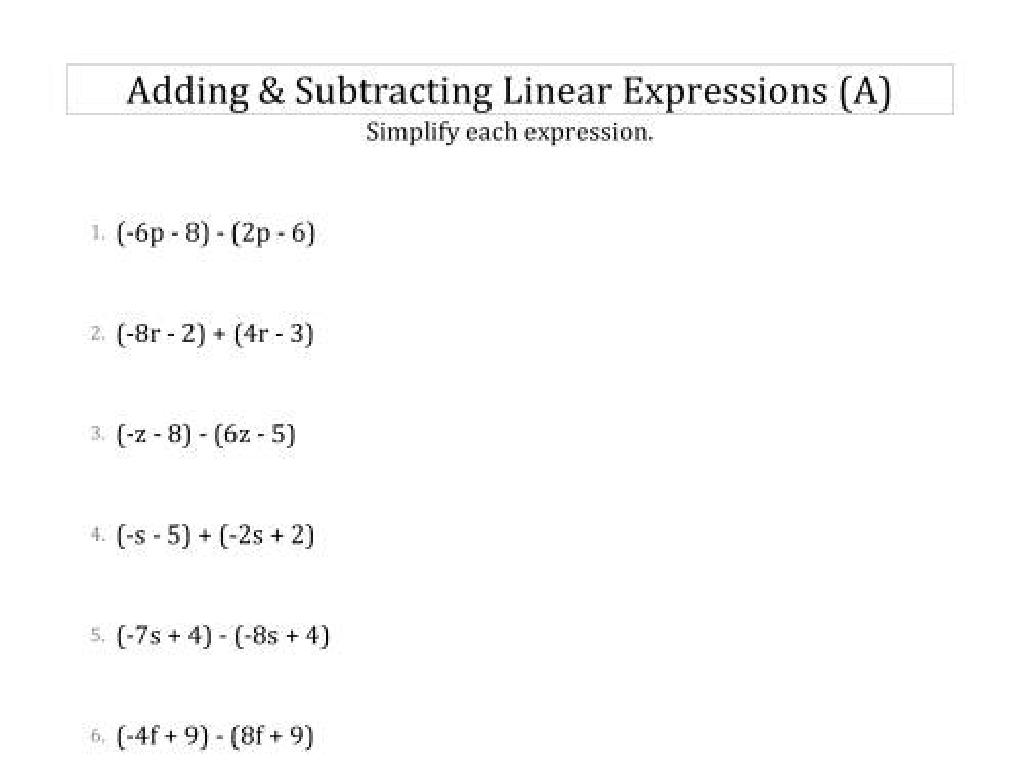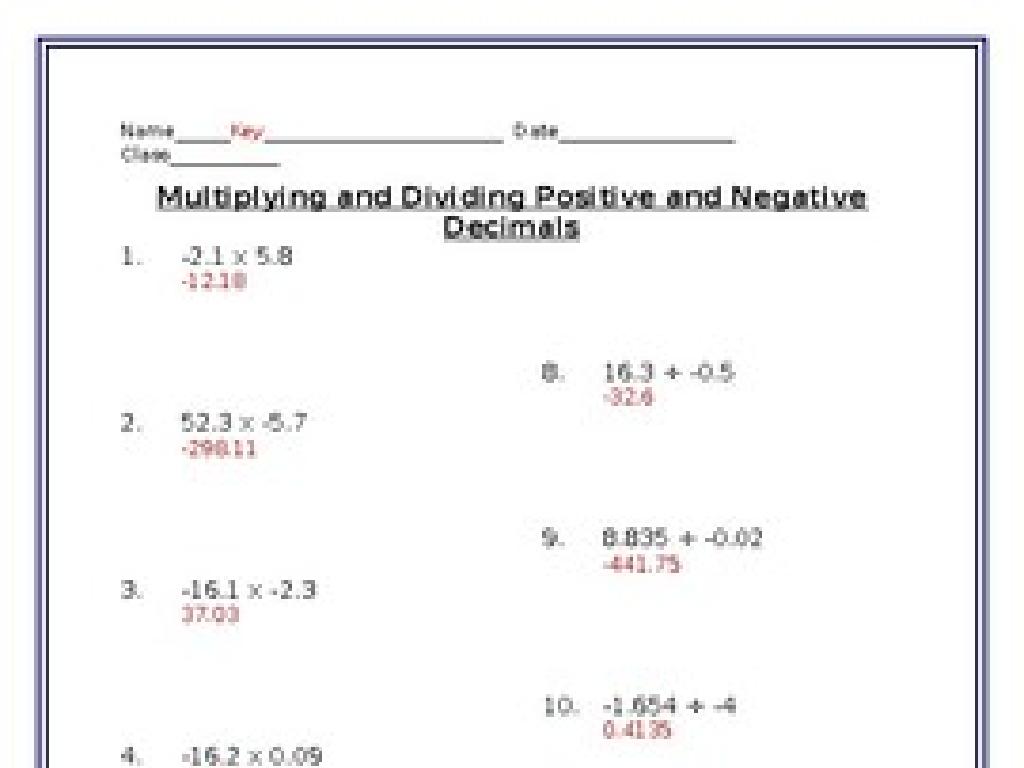Compare Fractions Using Models
Subject: Math
Grade: Fourth grade
Topic: Compare And Order Fractions
Please LOG IN to download the presentation. Access is available to registered users only.
View More Content
Welcome to Fractions: Comparing Parts of a Whole
– Learn to compare fractions
– Understand parts of a whole
– A fraction represents a part of a whole, like a slice of pizza.
– Significance of fraction comparison
– Comparing fractions helps us understand which part is bigger or smaller.
– Real-life application of comparing fractions
– Use fraction comparison when sharing treats, dividing time, or measuring ingredients.
|
This slide introduces the concept of comparing fractions, which is a fundamental skill in understanding parts of a whole. Begin by explaining that a fraction represents a piece of something, such as a slice of pizza out of a whole pizza. Emphasize the importance of comparing fractions in everyday life, such as determining who has more pizza, dividing time for activities fairly, or measuring ingredients for a recipe. Provide visual aids like pie charts or bar models to help students visualize the fractions. Encourage students to think of other examples where they might need to compare fractions in their daily lives. This will help them see the relevance of what they’re learning to the real world.
Understanding Fractions
– A fraction represents part of a whole
– Numerator and denominator explained
– The top number (numerator) shows how many parts we have. The bottom number (denominator) shows how many parts the whole is divided into.
– Fractions in daily life
– Pizza slices, a glass of water, and sharing candy are everyday examples of fractions.
– Visualizing fractions with models
– Using shapes like circles or bars divided into equal parts to see fractions.
|
Begin by explaining that a fraction represents a part of a whole, something that is less than a single unit but more than zero. Clarify the roles of the numerator and denominator in a fraction. Provide relatable examples of fractions that students encounter in their daily lives, such as slices of pizza or dividing a bag of candy among friends. Introduce models such as pie charts or bar models to visually represent fractions, which will help students better understand and compare them. Encourage students to think of their own examples and draw models to represent the fractions they come up with.
Visualizing Fractions with Models
– Fractions as shapes: circles and bars
– Picture a pizza cut into equal slices; each slice is a fraction of the pizza.
– Exploring fraction models
– Let’s use shapes to see how 1/2 is bigger than 1/4.
– Comparing fractions visually
– Place two fraction models side by side to see which is larger or smaller.
– Benefits of using models
– Models make abstract concepts concrete, aiding in comprehension.
|
This slide introduces students to the concept of visualizing fractions using models such as circles (like pizzas) and bars (like chocolate bars). By representing fractions with shapes, students can more easily understand and compare the sizes of different fractions. Show examples of different fractions using these models and guide students to see which fractions are larger or smaller by comparing the models side by side. Emphasize that using models helps to make the abstract concept of fractions more concrete and understandable, which is particularly helpful for visual learners. Encourage students to draw their own models to compare fractions as a class activity.
Understanding Equivalent Fractions
– Fractions can be equal
– 1/2 is the same as 2/4 or 3/6
– Models show equivalent fractions
– Draw shapes divided into equal parts
– Practice with fraction models
– Use shapes to see which fractions are the same
– Identifying equal fractions
|
This slide introduces the concept of equivalent fractions, emphasizing that different-looking fractions can represent the same quantity. Begin by explaining that fractions like 1/2, 2/4, and 3/6 all have the same value, using visual models such as pie charts or bar models to illustrate this point. Encourage students to draw their own models to find equivalent fractions. Provide practice opportunities with various models to help students become comfortable with identifying equivalent fractions visually. Reinforce the idea that equivalent fractions are just different ways of expressing the same part of a whole.
Comparing Fractions with the Same Denominator
– Compare fractions: same denominator
– Look at the top number when bottoms are the same
– Larger numerator means larger fraction
– Think of slices of pizza: more slices, more pizza!
– Example: Which is larger, 3/8 or 5/8?
– 5/8 has more pieces than 3/8, so it’s larger
|
This slide is focused on teaching students how to compare fractions that have the same denominator. Emphasize that the denominator represents the total number of equal parts, and when it’s the same, they only need to look at the numerators to determine which fraction is larger. Use the pizza analogy to make it relatable – if a pizza is cut into 8 slices, having 5 slices (5/8) is definitely more than having 3 slices (3/8). Encourage students to visualize or draw models to compare fractions and understand the concept better. Provide additional examples for practice and ensure they grasp that the fraction with the larger numerator is the larger fraction when denominators are equal.
Comparing Fractions with Different Denominators
– Find equivalent fractions
– To compare, make the bottoms of fractions (denominators) the same
– Use models for understanding
– Draw shapes divided into equal parts to visualize
– Example: 1/4 vs 2/6
– Show 1/4 and 2/6 on pie charts to compare sizes
– Practice with models
|
When fractions have different denominators, we can’t compare them directly. Teach students to find equivalent fractions with a common denominator to make comparison easier. Use visual aids like fraction models or pie charts to help students see the differences in fraction sizes. For example, draw a circle divided into 4 and another into 6 to compare 1/4 and 2/6. Encourage students to draw their own models and practice with different fractions to build a strong understanding of the concept.
Using Benchmarks to Compare Fractions
– Understand benchmarks 0, 1/2, and 1
– Compare fractions to 1/2
– Is it closer to 0, 1/2, or 1?
– Practice with 3/5 and 4/7
– Which is larger, 3/5 or 4/7? Use 1/2 as a reference.
– Decide less than, equal, or more
– Use benchmarks to determine the relationship
|
This slide introduces the concept of using benchmarks to compare fractions. Benchmarks are standard points of reference that students can use to evaluate fractions quickly. By comparing fractions to 0, 1/2, and 1, students can determine if a fraction is less than, equal to, or greater than these benchmarks. For example, both 3/5 and 4/7 are more than 1/2. To practice, students will compare 3/5 and 4/7 using 1/2 as a benchmark. They will decide which fraction is larger by determining their position relative to 1/2. This exercise will help solidify their understanding of fractions and their ability to compare them using benchmarks. Encourage students to visualize fractions on a number line or with fraction circles to aid comparison.
Let’s Practice Comparing Fractions!
– Practice comparing fractions
– Compare 2/3 and 3/4 using models
– Use fraction circles or bars to visualize
– Discuss with a partner
– Share ideas on which is larger or smaller
– Explain your reasoning
– How did the models help you decide?
|
This slide is designed to engage students in a hands-on activity to deepen their understanding of comparing fractions. Provide students with fraction models, such as circles or bars, to compare 2/3 and 3/4 visually. Encourage them to work with a partner to foster collaborative learning and communication skills. They should discuss which fraction is larger and use the models to support their reasoning. As a teacher, walk around the classroom to facilitate discussions, ask guiding questions, and ensure that students are correctly interpreting the models. Possible activities include drawing their own fraction models, using manipulatives, or creating real-life scenarios where they might have to compare fractions.
Class Activity: Fraction War Game
– Pair up for ‘Fraction War’
– Each pair receives a fraction deck
– Flip and compare fractions
– Is 1/2 or 3/4 greater? Use models if needed.
– Win rounds with higher fractions
|
This interactive game helps students understand fraction comparison in a fun and engaging way. Each pair of students will receive a deck of cards with fractions on them. They will play by flipping over the top card of their decks simultaneously and comparing the fractions. The student with the higher fraction wins the round and takes both cards. If the fractions are equal, it’s a ‘war,’ and additional cards are flipped until a winner is determined. The game continues until all cards have been played. The teacher should circulate the room to ensure understanding and correct use of fraction comparison strategies. Possible variations of the game can include using visual fraction models, number lines, or creating equivalent fractions for comparison.
Great Work on Fractions!
– Congratulations on learning comparison!
– Homework: Fraction worksheet
– Complete the provided worksheet to practice
– Use models for homework help
– Draw pie charts or bar models to visualize fractions
– Remember benchmarks in comparison
– Benchmarks like 1/2 can guide your understanding
|
This slide wraps up the lesson on comparing fractions and transitions students to applying their knowledge through homework. The worksheet will reinforce the concepts learned in class, such as using visual models like pie charts or bar graphs to compare different fractions. Remind students to use benchmarks, like 1/2, to determine which fractions are larger or smaller. Encourage them to think about the size of the pieces and the number of pieces to compare fractions effectively. For the next class, be prepared to review the homework answers and address any questions or difficulties the students encountered.






